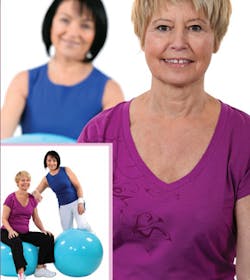Working smarter, not harder, to provide patient services
By Jamie Collins, RDH, CDA
In business it all comes down to the bottom line and how we can make more with what we have. In reality, we usually have only one hour with each patient to complete all of the "routine" procedures, and the thought of adding one more thing can be maddening. How many of you are pressed by your dentist for just a little more production? There are goals to be met and overhead to be covered, and this can become stressful for the entire staff.
In many offices there is a production bonus for exceeding set goals, and this benefits both the staff and dentist. We can increase the production and income of the hygiene department and practice without much added work. It all comes down to working smarter, but not necessarily harder.
Smile Comparisons
A good leading question for patients is asking them what they would change about their smiles if they had the chance. The majority of patients I talk to say they would like a whiter smile, and many don't realize it's possible and relatively inexpensive. It can be quick and easy to spark interest and generate extra income during conversations with patients. As clinicians, we should be performing intraoral and extraoral exams with each patient.
----------------------------------------------------
Other articles to consider reading:
- Six tips to increase treatment acceptance
- Human Resources for Dental Offices: Uniform policies, and two-week notices
- Preparing your practice for increased competition
----------------------------------------------------
Next time, take an extra 30 seconds to show them the tooth shade guide for an initial shade to enter into the chart. Curious patients will question why you're taking a shade. Explain how teeth can change and darken over time with age, diet, and other factors, and that you're keeping track of changes for future reference. This will get patients thinking about their shade and smile.
When you show patients the shade guide and where their teeth are now, many want to know how to get a whiter shade. As you move on with the appointment, the foundation has been set to discuss whitening options, whether it's take-home bleach trays, in-office whitening, or something more involved such as veneers or crowns.
The cost to take impressions and make bleach trays is minimal; however, the potential for income is great for many reasons. Patients are happy to have the desired whitening effect, and the result is that many will talk to friends and hopefully generate referrals to the practice. In addition, they will purchase whitening gel during future visits to touch up their glowing smiles. Those 30 seconds of added effort during a dental visit have the potential to generate easy profits for years to come.
Additional Inventory
The majority of dental insurance companies do not cover an in-office fluoride treatment for adults. In my experience, if the benefits of fluoride treatment are explained to patients who have hypersensitivity or a high caries rate, they often choose to receive in-office fluoride and understand that it is a small added expense for a good potential benefit. Paying a small amount for a fluoride varnish treatment to decrease sensitivity makes the expense worth it for most patients. We never know what a patient values or may be willing to pay unless we offer it.
We have all discussed the increased caries rate with people and looked for options to decrease the risk. What percentage of Americans chews gum or mints throughout the day? How about recommending xylitol mints or gum?
Studies have shown that xylitol can decrease the caries rate, and xylitol products are available in mints, gum, toothpaste, rinses, and nasal sprays. It is safe for all ages and for diabetics, as it is a sugar substitute that does not significantly raise glucose levels. Don't forget to warn people of the potential side effects if these products are consumed in large quantities. Most people don't experience side effects if they don't consume more than 5 mg per day. While there are many brands available over the counter, keep xylitol in office as well. We're a society of convenience, and having a few in the office does not take up much space and allows for a quick and easy profit.
Chlorhexidine rinses are commonly used for periodontal disease, post oral surgery, and caries prevention. It is not available over the counter and must be dispensed by prescription or in office per state regulations. Many dental offices use chlorhexidine as a preoperative rinse, whether it's in the hygiene department or the doctor's chair. Offices already purchase it for in-office use, so having patient-use bottles available for purchase is a logical production booster. The bottle must have a label attached with the prescription and instructions for use before patients can take it home. As a reminder, chlorhexidine should not be used within 30 minutes of brushing.
From my experience as a clinical hygienist, the biggest added time is needed when we have a child or teenager in the chair in need of sealants. After the dentist has diagnosed the need for sealants, and if state law allows, placing the sealants during the same visit as the prophylaxis is an added convenience for the parent or guardian. The additional five to 10 minutes to place dental sealants has the potential to boost the daily production greatly. The extra time has the opportunity to generate an additional few hundred dollars for the office, and potentially for the hygienist if it is a production-based pay rate or bonus system.
Throughout my years in dentistry working and substituting in offices, I've seen several different profit-sharing or bonus systems. When production and collections remain steady and the overhead is covered, a dentist is more likely to implement a bonus system for the staff members, whether it's through the paycheck or little things such as parties or gift cards. A few offices I worked at had a system that was implemented when a hygienist produced over a certain amount for the day, and the additional production above and beyond was shared at a percentage with the hygienist. I had months when I earned an extra $100 to $400. What better incentive to increase office production than a little extra cash? I have friends who work on commission-only basis, and others that work for a low base salary in addition to a percentage of production. Other offices have a profit-sharing plan based on the retail sales, and all profits are then divided up among staff members as a thank you for their hard work.
Approaching the dentist with ideas for a bonus system can benefit not only the dentist and hygienist, but can also prove to be profitable for everyone. As an educator as well as clinician, I've heard many dentists say they would like to do more for their teams to show their appreciation for their hard work. Adding retail items to the practice may be an added convenience for patients that will increase compliance, and it may also increase the bottom line.
Shopping in the office
I recommend a power toothbrush as part of my home-care instructions for a majority of my patients, and I'm sure many of you do as well. Some offices recommend certain brands. My office offers the two major brands. Often a patient will ask for a brand recommendation, and keeping both on hand and charged allows people to hold and feel the action the power toothbrushes offer. We've all explained the benefits of power toothbrushes versus manual brushes, and by allowing patients to hold and touch, they're able to see and feel the difference.
How many times have we put off buying something or forgotten to pick up something, even if it was recommended by a health-care professional? By keeping the brushes in the office and having a professional recommend them, many patients will conveniently purchase on site. As consumers, we like to have choices in products without being overwhelmed by the options. Having choices on a few different models at different prices allows patients to purchase brushes within their budgets. My office has learned that many flexible spending accounts cover the cost of a power toothbrush if it's purchased in the office. This makes it a win-win for the patient and office, adding easy production for the practice.
Now your patients have beautiful white teeth and are using power toothbrushes, but how is the caries rate? We all have those patients who have one or two new cavities every six months, and they just can't figure out why. We discuss the options to reduce the caries rate, ranging from fluoride treatments to xylitol and chlorhexidine. Does your office have these products on hand for patients to purchase, or do you phone in a prescription? Having a small supply in the office is convenient for patients, freeing them from having to drive to pick up a prescription, thus increasing the likelihood of patient compliance.
Jamie Collins, RDH, CDA, resides in Idaho with her husband, Cory, and their four children. She currently works as a full-time hygienist as well as an educator at the College of Western Idaho. In addition, she acts as a content expert and contributor in multiple upcoming textbooks. She can be contacted at [email protected].
Past RDH Issues







